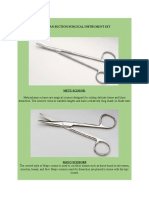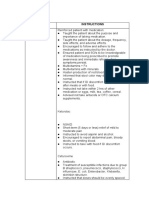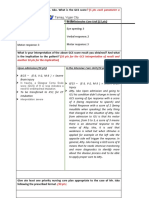Or Instruments
Or Instruments
Uploaded by
Jell KohCopyright:
Available Formats
Or Instruments
Or Instruments
Uploaded by
Jell KohCopyright
Available Formats
Share this document
Did you find this document useful?
Is this content inappropriate?
Copyright:
Available Formats
Or Instruments
Or Instruments
Uploaded by
Jell KohCopyright:
Available Formats
Surgical Instruments
CUTTING INSTRUMENT 1. Suture Scissors - are autoclavable and made from surgical stainless steel. The basic tip design may be pointed or blunt ended. The blades are either hooked, curved or have a curved blunt blade to enable easy removal of sutures. The hook lets the medical personnel easily lift the sutures to be cut.
2. Mayo Scissors - Mayo scissors are a type of surgical scissor. They may be made from stainless steel or titanium and have a polished or brushed finish. Straightbladed Mayo scissors are designed for cutting body tissues near the surface of the wound. The curved style of Mayo scissor is used to cut thick tissues such as those found in the uterus, muscles, breast and foot.
3. Metzembaum Scissor - are surgical scissors designed for cutting delicate tissue. The scissors come in variable lengths and have a relatively long shank-to-blade ratio. They are constructed of tungsten carbide and blades can be curved or straight. The blade tips are blunt. 4. 5. Stitch Scissor - for stitch removal; have a hook-shaped point on one blade to hook under the stitch before cutting it with the opposing blade.
6. Bandage Scissor - are very popular in any health care facility because they are designed to safely lift bandages away from skin for easy cutting. The bottom blade of the scissor is longer and goes easily under the bandages. The blunt tip design of the scissor prevents accidental injury while making bandage removal very easy, smooth, and quick. The scissors safely lifts bandage away from skin for easy cutting.
7. Scalpel - small knife with a thin blade, used in surgical operations.
CLAMPING INSTRUMENTS
1. Mosquito Clamp - A small, straight or curved hemostatic forceps used to hold delicate tissue or compress a bleeding vessel.
2. Kelly clamp - a type of hemostat usually made of stainless steel. They resemble a pair of scissors with the blade replaced by a blunted grip. They also feature a locking mechanism to allow them to act as clamps. They may be used for occluding blood vessels, manipulating [tissues], or for assorted other purposes.
3. Crile Clamp - A clamp for temporary stoppage of blood flow
4. Peans Clamp - a curved or straight hemostatic clamp with serrations along the entire length of the jaw.
5. Allis Forcep - A straight grasping forceps with serrated jaws, used to forcibly grasp or retract tissues or structures.
6. Babcock - Forceps with loop blades which are also semicircular in sagittal cross-section. Designed to hold a short length of intestine without compressing it.
7. Ochsner - A strongly built, curved hemostat with rat-tooth tips to the blades. it is used to hold stronger organ or tissue
8. Foester sponge Forceps - Used to hold swabs or sponges for mopping up the site. Scissor-type operation with ratcheted handles. The blades are loops with serrated opposing faces. May be straight or, for better visibility of the site, curved.
RETRACTORS 1. Richardson Retractor - is a handheld medical instrument used during chest or abdominal surgery. Such retractors feature a handle and a long shaft with a wide hook, known as a blade, at the end. Surgeons use the blade to grasp soft tissue such as skin, muscle, or internal organs.
2. Army-Navy Retractor - is used to retract shallow or superficial incisions.
3. Deaver Retractor - is a surgical instrument used to hold the edges of an abdominal or chest incision open so that the surgeon is able to reach the underlying organs. It is a thin, flat instrument with curved ends. The curved ends of the retractor are placed at the edges of the incision and held there by hand or clamped into place. The Deaver retractor can be used to hold organs inside the abdominal cavity away from the surgical site.
4. Harrington Retractor - is used by surgeons to either actively separate the edges of a surgical incision or wound, or can hold back underlying organs and tissues, so that body parts under the incision may be accessed.
5. Malleable - is used to retract deep wounds. May be bent to various shapes.
6. Weitlander Retractor - a self-retaining instrument, shaped like a scissors but the blades open when the ratcheted handles are closed. The blades each have four downward-pointing, curved prongs which retain their position in a spread wound. It is used to retract shallow incisions.
7. Mayo Abdominal Retractor - For retraction in large abdominal surgeries
8. Self-retaining Retractor and Balfour - surgical instrument which is used by a surgeon to hold open abdominal incisions during a laparotomy. The device holds itself in place, leaving the hands of surgeon and assistants free to focus on surgical tasks.
ORTHOPEDIC INSTRUMENT 1. Bone Mallet - A heavy-headed surgical instrument used for driving a bone chisel.
2. Bone Elevator - A surgical instrument used to elevate tissues or to raise a sunken part, such as a depressed fragment of bone.
3. Bone Saw a type of saw which has been designed to cut through bone.
4. Bone File - It is a surgical instrument used for scrapping and filing bones or other form tissues. It is an instrument used in surgery to smooth the edges of a divided bone.
5. Bone Drill - A bone drill is a device used by surgeons to repair broken bones. The bone drill is used to create holes that surgical pins and screws attach to. The bone drill is made of surgical-grade materials and is able to operate without adversely affecting the open wound. The bone drill is also used when extracting bone marrow from a bone.
6. Gigli Saw - fexible wire saw used by surgeons for bone cutting. A gigli saw is used mainly for amputation surgeries, where the bones have to be smoothly cut at the level of amputation.
7. Lowmann Clamp - a clamp designed to hold fractured ends of bone in position while plates are screwed into place, and so on. Consists of opposing sets of incurving claws which can be screwed into a tight position.
8. Bone Chisel - a heavyweight steel chisel used for paring of the surface of bones.
9. Bone Curette - The standard equipment for curetting bone. Shaped like a miniature ice cream scoop it has very sharp and durable edges and a hand-filling, bulbous handle.
10. Rongeur - a strongly constructed instrument with a sharp-edged, scoopshaped tip, used for gouging out bone. A rongeur can be used to open a window in bone, often in the skull. It is used in neurosurgery to expose areas for operation.
11. Bone Cutter use for For cutting small bones and for skull dissections.
You might also like
- Basic Surgical InstrumentsDocument37 pagesBasic Surgical Instrumentsapi-2658787991% (33)
- Circulating Nurse ScriptDocument1 pageCirculating Nurse Scriptmaga.abigail.bsn100% (1)
- Cesarian Section Surgical Instrument SetDocument17 pagesCesarian Section Surgical Instrument SetHashmein Estrada Ramos100% (1)
- Muscles of The Upper Limb Made EasyDocument7 pagesMuscles of The Upper Limb Made Easynss93% (27)
- Cesarean Section and Surgical InstrumentsDocument35 pagesCesarean Section and Surgical InstrumentsHarry Cloth100% (2)
- TAHBSO Concept MapDocument1 pageTAHBSO Concept MapSherika Mariz Moreno GuarinNo ratings yet
- Surgical InstrumentsDocument4 pagesSurgical InstrumentsGlaizalyn Fabella Tagoon100% (1)
- Basic Concept Map - RH IncompatibilityDocument1 pageBasic Concept Map - RH IncompatibilityTechnoShindoNo ratings yet
- Clamping and Occluding InstrumentsDocument4 pagesClamping and Occluding InstrumentsDhanNie CenitaNo ratings yet
- Analytic Phase ResearchDocument5 pagesAnalytic Phase ResearchRosa MiaNo ratings yet
- 217 RF Peripheral Neurovascular DysfunctionDocument8 pages217 RF Peripheral Neurovascular Dysfunctionapi-271775750No ratings yet
- Mathematical Evaluation For Controlling HazardsDocument11 pagesMathematical Evaluation For Controlling Hazardsdambiente2100% (1)
- Surgical InstrumentsDocument8 pagesSurgical InstrumentsCassandra Grace Labial PaynterNo ratings yet
- Instruments PDFDocument26 pagesInstruments PDFTricia Andrei BonifacioNo ratings yet
- Retracting and Exposing InstrumentsDocument3 pagesRetracting and Exposing InstrumentsTherese Manalansan AlvarezNo ratings yet
- Major & Minor Surgical Instrument: ScalpelDocument7 pagesMajor & Minor Surgical Instrument: Scalpeledgar malupengNo ratings yet
- Khaye:: Traction: Is The Act of Pulling or Drawing Which Is Associated With Counter TractionDocument4 pagesKhaye:: Traction: Is The Act of Pulling or Drawing Which Is Associated With Counter TractionChloe MorningstarNo ratings yet
- Instruments Set1Document17 pagesInstruments Set1GLORY MI SHANLEY CARUMBA100% (1)
- Instruments - Grasping - HoldingDocument6 pagesInstruments - Grasping - HoldingBianca Freya PorralNo ratings yet
- Ex LapDocument42 pagesEx LapOmar Khalif Amad PendatunNo ratings yet
- SJMC - xi-nCP&HTP - Impaired Skin IntegrityDocument10 pagesSJMC - xi-nCP&HTP - Impaired Skin IntegrityJoy CompetenteNo ratings yet
- Anatomy and Physiology For HELLP SyndromeDocument6 pagesAnatomy and Physiology For HELLP SyndromeRosemarie Carpio100% (1)
- List of InstrumentsDocument3 pagesList of InstrumentsWafa L. AbdulrahmanNo ratings yet
- Instruments in Operating RoomDocument6 pagesInstruments in Operating Roomanna_villanueva_8No ratings yet
- Impaired Skin IntegDocument2 pagesImpaired Skin IntegMarcus Philip GonzalesNo ratings yet
- NCP H MoleDocument6 pagesNCP H MoleMina RacadioNo ratings yet
- Surgical EquipmentsDocument2 pagesSurgical EquipmentsChin ChanNo ratings yet
- Operating Room InstrumentsDocument2 pagesOperating Room InstrumentsGeorgia MarianoNo ratings yet
- Er NCPDocument9 pagesEr NCPEden Marie FranciscoNo ratings yet
- Operating Room WriteDocument2 pagesOperating Room WritemodiNo ratings yet
- 4th Rotation NCM207 Delivery Room NursingDocument14 pages4th Rotation NCM207 Delivery Room NursingPadilla, John AndrewNo ratings yet
- TAHBSODocument14 pagesTAHBSOSheena Mae Atienza100% (2)
- NSO - Adam's Forward Bend TestDocument2 pagesNSO - Adam's Forward Bend TestMaha AmilNo ratings yet
- Basic Surgical Instruments PDFDocument33 pagesBasic Surgical Instruments PDFAndreas Berkat ElloirahmatdiNo ratings yet
- Complications With The Power of LaborDocument8 pagesComplications With The Power of LaborEdrea Aquino MendezNo ratings yet
- Discharge Plan Methods InstructionsDocument5 pagesDischarge Plan Methods InstructionsKirk CabasaNo ratings yet
- Risk For Compromised Human Dignity NCPDocument3 pagesRisk For Compromised Human Dignity NCPMarife Lipana Reyes100% (3)
- Chn-Herbal MedicineDocument5 pagesChn-Herbal MedicineBSN 1-N CASTRO, RicciNo ratings yet
- A Woman Who Has Had Two or More Pregnancies Resulting in Potentially Viable OffspringDocument5 pagesA Woman Who Has Had Two or More Pregnancies Resulting in Potentially Viable Offspringhey aadarsha100% (1)
- Narrative Report Day 2Document2 pagesNarrative Report Day 2Maria Arabella LanacaNo ratings yet
- Mayo CurveDocument6 pagesMayo CurveDanielle Marie SimoraNo ratings yet
- NCP Systemic Viral Infection SVIDocument4 pagesNCP Systemic Viral Infection SVIPavel Kolesnikov100% (1)
- ClubfootDocument22 pagesClubfootJhong Xyrus100% (3)
- RetractorsDocument18 pagesRetractorsNicole SooNo ratings yet
- Or InstrumentDocument23 pagesOr InstrumenttabiNo ratings yet
- PrioritizationDocument1 pagePrioritizationJLAZRONo ratings yet
- C-Section InstrumentsDocument18 pagesC-Section Instrumentsविजय मैनाली100% (1)
- NCP Breast CADocument3 pagesNCP Breast CAHannah Lacambra100% (1)
- Upon Admission (15 PTS) in The Intensive Care Unit (15 PTS) : ? (5 Pts Each Parameter A Total of 15 Points)Document5 pagesUpon Admission (15 PTS) in The Intensive Care Unit (15 PTS) : ? (5 Pts Each Parameter A Total of 15 Points)Janelle Cabida SupnadNo ratings yet
- Nursing Care For Patient Undergoing TAHBSO For Ovarian GrowthDocument4 pagesNursing Care For Patient Undergoing TAHBSO For Ovarian Growthsugarmontejo83% (6)
- Delivery Room InstrumentsDocument2 pagesDelivery Room InstrumentscattleyaNo ratings yet
- Shantz Collar TaylorDocument3 pagesShantz Collar TaylorRaisah Bint AbdullahNo ratings yet
- NCP Anxiety RT Diagnostic ProcedureDocument2 pagesNCP Anxiety RT Diagnostic ProcedureJenny Ajoc0% (1)
- OR Write Up - Repeat LSCSDocument2 pagesOR Write Up - Repeat LSCSWyen CabatbatNo ratings yet
- ReqsDocument4 pagesReqsDanilo Clerigo Sr.100% (2)
- OR InstrumentsDocument56 pagesOR Instrumentssellyna SaidinNo ratings yet
- Surgical InstrumentDocument7 pagesSurgical InstrumentLabinnah MoresNo ratings yet
- Operating Room Nursing: Marissa S. Fernandez, RN, Man Clinical InstructorDocument29 pagesOperating Room Nursing: Marissa S. Fernandez, RN, Man Clinical InstructorKceey CruzNo ratings yet
- Common or InstrumentsDocument16 pagesCommon or InstrumentsCosmic PhilippinesNo ratings yet
- Study The Following Instruments. Be Able To Identify and Know Its UsesDocument2 pagesStudy The Following Instruments. Be Able To Identify and Know Its UsesJay VillasotoNo ratings yet
- This Is Surgical Instruments Lecture Notes For Medical StudentsDocument51 pagesThis Is Surgical Instruments Lecture Notes For Medical StudentsFrida RasyidNo ratings yet
- Basic Instruments in The Operating RoomDocument6 pagesBasic Instruments in The Operating RoomAbegail M. TolosaNo ratings yet
- ChimpDocument8 pagesChimppropernounNo ratings yet
- Homeopathy Cases by KadwaDocument179 pagesHomeopathy Cases by Kadwaabckadwa100% (3)
- SomatecDocument123 pagesSomatecAdi kurniantoNo ratings yet
- SVM-14004-1 Ras-18-22g2kcv-Id-1 PDFDocument110 pagesSVM-14004-1 Ras-18-22g2kcv-Id-1 PDFdafrie rimbaNo ratings yet
- Eaton Arc Flash HandbookDocument32 pagesEaton Arc Flash Handbookr4kin100% (1)
- Wound Repair: Chapter OutlineDocument6 pagesWound Repair: Chapter OutlineAnna NgNo ratings yet
- Ramos Vs Col RealtyDocument2 pagesRamos Vs Col RealtyAnonymous 1MbKoiZ3AFNo ratings yet
- Dance 5GemsofFlexibility Ebook NewDocument30 pagesDance 5GemsofFlexibility Ebook NewThais Lino100% (3)
- StretchingDocument15 pagesStretchingMagd.islamgmail.com MagdislamNo ratings yet
- Bubbles HeDocument39 pagesBubbles HePerrilyn PereyNo ratings yet
- Cheese Rolling TextoDocument3 pagesCheese Rolling TextoEvelyn Añamuro AñamuroNo ratings yet
- Adductor Magnus An EMG Investigation Into Proximal and Disctal Portions and Direction Specific ActionDocument9 pagesAdductor Magnus An EMG Investigation Into Proximal and Disctal Portions and Direction Specific ActionElaine CspNo ratings yet
- University of The Philippines College of Law: City of Manila V TeoticoDocument2 pagesUniversity of The Philippines College of Law: City of Manila V TeoticoMaribel Nicole LopezNo ratings yet
- G.R. No. 209464Document23 pagesG.R. No. 209464JoJONo ratings yet
- 1ST Quarter Examination in Mapeh 9Document6 pages1ST Quarter Examination in Mapeh 9Christian de Veyra DavidNo ratings yet
- BasketballDocument4 pagesBasketballapi-514548596No ratings yet
- The Wrist ComplexDocument35 pagesThe Wrist ComplexKeshav Singhmaar AryaNo ratings yet
- Fibrodysplasia Ossificans Progressiva (FOP)Document19 pagesFibrodysplasia Ossificans Progressiva (FOP)AkiNo ratings yet
- WAH ToolkitDocument74 pagesWAH ToolkitKhuda BukshNo ratings yet
- Hip and PelvisDocument59 pagesHip and PelvisIbNu OmErNo ratings yet
- User Manual Solidline AirDocument12 pagesUser Manual Solidline Airsoc_neprofitni_stanovi_2008No ratings yet
- Cy22 Smog Final 2Document320 pagesCy22 Smog Final 2Doc FigNo ratings yet
- Hans Von Mangoldt GMBH & Co. KG D-52080 Aachen, GermanyDocument44 pagesHans Von Mangoldt GMBH & Co. KG D-52080 Aachen, Germanybrco11No ratings yet
- The Shoulder Replacement Book: Frank Norberg, MDDocument8 pagesThe Shoulder Replacement Book: Frank Norberg, MDRammah EmadNo ratings yet
- Power Wheels Harley RockerDocument21 pagesPower Wheels Harley RockerChuckDaddyNo ratings yet
- Industrial Tribology WearDocument23 pagesIndustrial Tribology WearAtif HashmiNo ratings yet
- Burning For More - Kaye KennedyDocument272 pagesBurning For More - Kaye KennedyizzieseNo ratings yet
- Use of English File: Unit 6: AccidentsDocument20 pagesUse of English File: Unit 6: Accidentsjustthhua-1No ratings yet

























































































